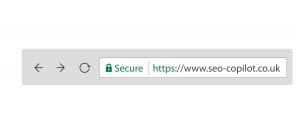Disclosure: This post has affiliate links. I earn a commission at no extra cost to you. I only recommend products I personally believe in. More info on my Privacy Policy page.
Why You Need to Switch from HTTP to HTTPS
Table of Contents
There has been warnings by Google for over a year about making sites more secure by using HTTPS, and now a deadline has been set – July 2018.
By July this year, all sites must switch from HTTP to the more secure HTTPS through a SSL (Secure Sockets Layer) certificate to avoid Chrome giving warnings about the sites security. Not making the transfer to HTTPS could have serious negative impacts to your business – it is not something you can brush under the carpet!
First things first – what is HTTPS?
Hypertext Transfer Protocol Secure (or HTTPS) is a security feature which ensures that visitors to your site are protected in terms of confidentiality of data.
Before now, it didn’t matter too much if a site was using HTTP as there was not much warning from search engines and not much impact on rankings. Now this new update is taking place, not having a HTTPS certificate will not only bring up a warning to visitors to your site, but it could actually bring your site down in search rankings. This could mean all your hard work and/or money put into ranking above competitors could all be erased by simply not following Google’s warnings.
Google’s announcements
So Google’s first warning was given on the 19th August 2017, where is warned users that making the choice to keep using HTTP rather than HTTPS runs the risk a security warning pop-up showing to visitors to your site using a Chrome browser, with the deadline being October 2017. It also warned that not making the switch could impact on traffic to your site, as visitors are likely to be put off by the warning.
The most recent announcement (February this year) warned that the change is still going to happen, but gave a deadline of July 2018.

This is an example of what an HTTPS secure site URL should look like
The importance of a secure site
Google are not pushing for HTTPS for no reason, it is very important for your business and for your visitors’ peace of mind to have a secure site. It is especially important for sites which collect customer data regularly, including personal details and credit/debit card information.
Using HTTP allows anyone to hack your computer and take the information stored about your customers, which is obviously going to put customers off staying and giving any personal information.
HTTPS, on the other hand, is far more secure and will prevent customer data from being leaked, which is why it is encouraged by Google. The reason that Google are now penalising sites which don’t use HTTPS is for their user’s experience. They want their users to trust the sites they show, which is why they are giving the most secure sites first.
CLICK TO TWEET
The ‘HTTPS Everywhere’ presentation explains further the reasons mentioned previously about switching to HTTPS for improved security including how the certificate helps with authentication, data integrity and encryption.
Other helpful resources:
SSL Certificate Checker
Moz Blog – Half of page one is https
Moz Blog Https tips

